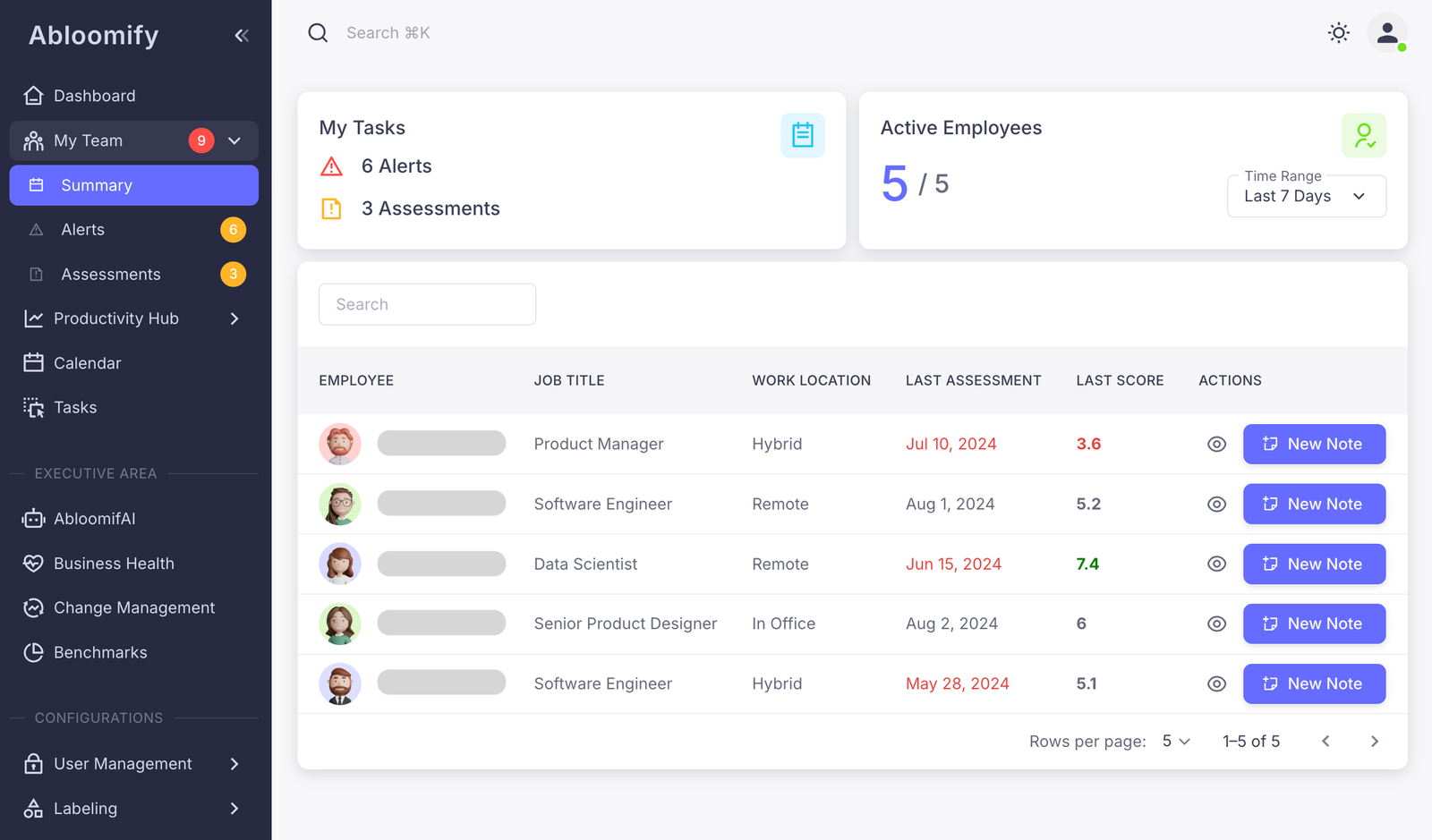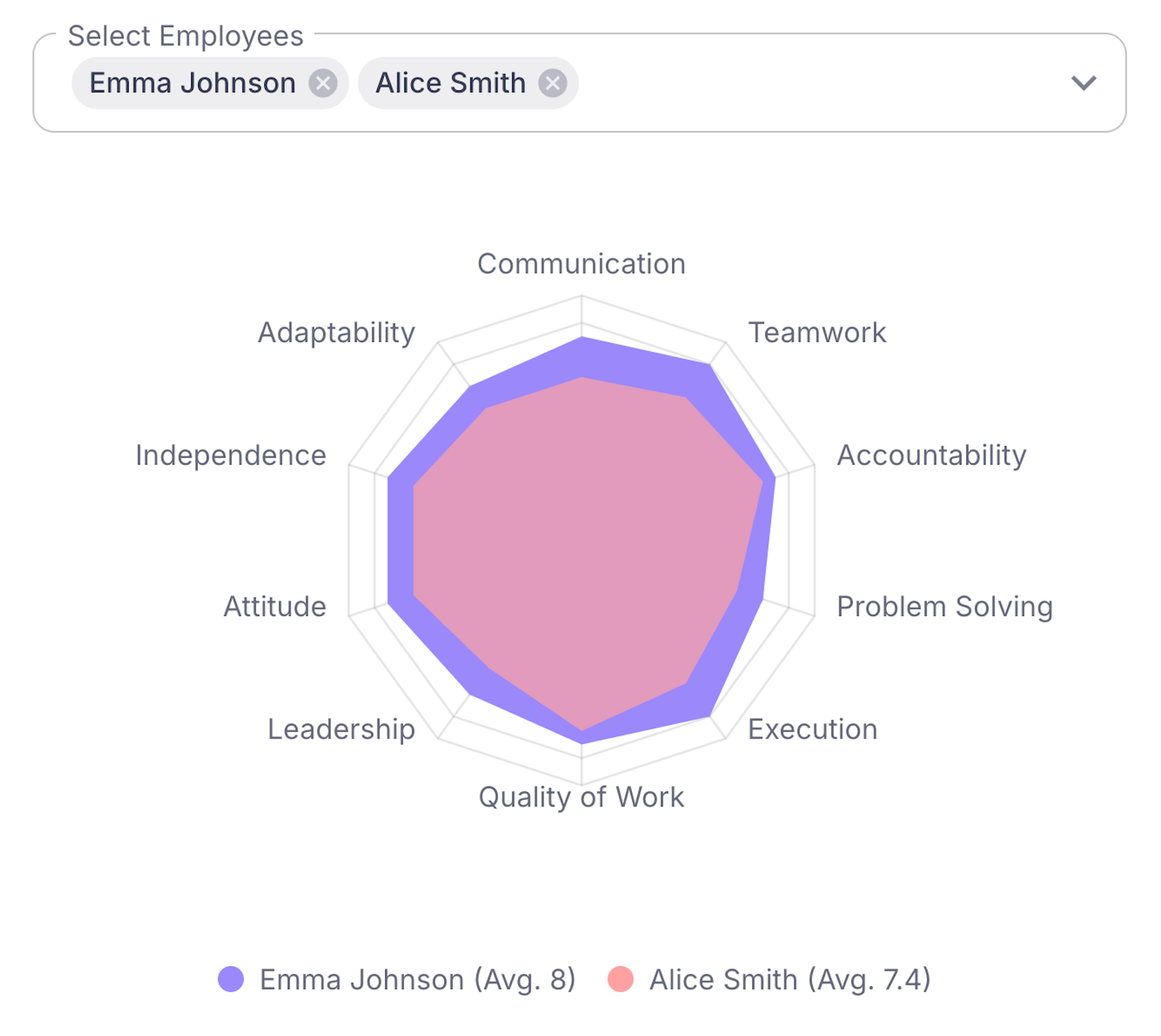Employee involvement in performance management is crucial for building high-performing teams. Explore which parts of the process benefit most from employee engagement, and how leveraging tools like Abloomify’s AI platform can drive productivity and growth.
Understanding Performance Management
Organizations strive for success by continually fine-tuning their performance management practices. Performance management isn’t just about setting goals and reviewing them. It’s about nurturing a culture where employees feel genuinely engaged and involved.
Performance management systems often include goal setting, feedback loops, and performance reviews. These mechanisms help align individual achievements with organizational objectives. However, true success in performance management comes with involving employees at every stage. When employees have a say in their performance evaluations, they are more likely to be engaged and motivated.
Why is employee involvement crucial? Consider these insights:
- Employees who participate in setting their own goals feel a greater sense of ownership. This encourages commitment to achieving these targets.
- Incorporating self-assessments provides a richer perspective on individual progress. This helps in identifying areas of improvement that might be overlooked by top-down processes.
- When employees provide input on their performance evaluations, it leads to transparency and trust within the organization.
Collaboration in performance management isn’t just a nice-to-have. It’s essential for sustainable growth and continuous improvement. AI-powered tools offer ways to enhance this collaboration through real-time assessments. These resources empower teams to track progress and make informed decisions. Leveraging such tools, organizations can transform their approach to performance management, leading to enhanced productivity and growth.
For a deeper dive into modern strategies, consider exploring Abloomify’s insights into performance management. Each interaction counts, shaping a framework that elevates everyone involved towards greater success.
The Benefit of Employee Feedback
Feedback is not just about topping up the suggestion box. It’s the lifeblood of performance management, serving as both a mirror and a map. Employee feedback is where the magic happens. When employees are involved in feedback mechanisms, they become co-authors of their own professional journey.
Think of feedback tools as lenses that sharp-focus the collective vision. Implement mechanisms such as:
- Regular one-on-one check-ins
- Anonymized surveys
- Peer reviews
These mechanisms cultivate a climate where employees feel valued and heard. Improved satisfaction is merely a headline; the story lies in enhanced performance metrics and innovative solutions.
Enter a 360° feedback tool, offering insights at crucial points. It’s akin to having a real-time GPS that navigates not just terrain but untrodden paths. This tool enables managers to gather information from multiple perspectives, ensuring a holistic evaluation.
Real-world examples abound. Consider a company that integrated a robust feedback system, seeing a 20% increase in team productivity. Another saw employee engagement spike by 30% post-implementation.
Feedback isn’t just an element; it’s an engine igniting a well-oiled performance machine. An organization that embraces continuous feedback as part of its performance management system can transform into a dynamic force. Being responsive to employee voices is not only wise management; it’s a strategic advantage in a rapidly evolving landscape.
For deeper insights into optimizing feedback channels, explore how to work performance management systems.
Setting Meaningful Goals Collaboratively
Involving employees in setting meaningful goals not only aligns their efforts with organizational objectives but also fuels their intrinsic motivation. It’s about more than just ticking boxes; it’s about collaboratively charting a course where purpose meets performance.
Start by inviting employees into the conversation. Rather than dictating their targets, engage them in understanding the bigger picture. Facilitate workshops where team members brainstorm how their roles contribute to company milestones. This collective insight fosters a shared vision, enhancing commitment and clarity.
Use structured frameworks like SMART to turn these brainstorming sessions into actionable goals. Encourage employees to draft initial goals using SMART criteria, focusing on Specific, Measurable, Achievable, Relevant, and Time-bound aspects. Such goal-setting not only ensures feasibility but also propels clarity and precision.
Digital tools powered by AI can streamline this process. They provide data-driven insights into employee strengths, enabling tailored goal-setting. This targeted approach balances individual aspirations with organizational needs, fostering a deeper dedication to goal achievement.
Here’s how AI-powered career path planning tools effectively facilitate this:
- They highlight personal growth opportunities within the organizational context.
- They align employee goals with broader business objectives using predictive analytics.
- They provide real-time progress tracking, offering feedback and adjustment avenues.
Such technologies ensure the goal-setting process is dynamic, adaptable, and data-informed. Employees find meaning in their work, propelling higher engagement and productivity. This shift from traditional, top-down goal-setting to a more inclusive approach speaks to transformational performance management practices. It’s about empowering employees to own their development journey, creating a culture where both individuals and organizations thrive in tandem.
Effective Performance Reviews
The classic performance review often feels like an unwelcome audit. Traditional reviews tend to be backward-looking and rigid, often missing the nuance of individual contribution and growth. Employees are measured by criteria they had little part in defining, resulting in evaluations that can feel more like judgment than a tool for improvement.
Instead of a retrospective interrogation, envision a more dynamic process, where employees participate in creating the performance narrative. In this model, reviews become a platform for engagement, revealing insights that are a confluence of personal aspirations and organizational goals.
Why involve employees?
– Ownership: Employees who have a hand in shaping their performance metrics tend to feel more accountable. They see the direct impact of their contributions, fostering a sense of ownership.
– Growth: Constructive dialogue replaces apprehension. Feedback becomes an ongoing conversation rather than a one-off formality.
– Clarity: Continuous input from employees ensures that the performance metrics are clear and aligned with personal and team goals.
Emerging AI solutions elevate this process even further. Through continuous assessment, AI platforms track and analyze performance throughout the year. This technology-driven approach supplements human insights with data-driven precision, offering real-time feedback. Such systems enrich evaluations, creating an experience that is less about ratings and more about mutual growth.
For organizations aiming to evolve, embracing these contemporary methods facilitates a shift from static reviews to multidimensional evaluations. This not only empowers employees but also enhances organizational agility and effectiveness. Explore how to improve performance management to see how innovation can redefine evaluations.
Leveraging Technology for Engagement
The fusion of technology with performance management is not about replacing the human touch, but about enhancing it. Imagine a world where administrative drudgery dissipates, leaving room for creative engagement. That’s the promise technology offers. Platforms have emerged that turn cumbersome tasks into strategic opportunities for engagement.
Consider these transformative tools:
- Automated meeting scheduling: It ensures timely, efficient interactions, freeing up mental bandwidth for meaningful dialogue.
- Productivity alerts: They offer insights that keep employees informed and focused, supporting continuous improvement.
These tech marvels light the path from a transactional relationship to one centered on growth and contribution. Employees no longer feel like cogs in the wheel. They become collaborators in the performance process, actively participating in real-time feedback and goal setting.
The real magic happens when technology translates numbers and data into actionable insights. It allows employees to visualize their contributions and areas of improvement. An engaged employee is an empowered one, and empowerment leads to a high-performing culture.
For organizations, it’s about leveraging workforce analytics to unlock potential, ensuring that every interaction is a step toward improvement. This is not just an evolution; it’s a revolution driving engagement. As tech alleviates burdensome tasks, it reimagines performance management as an arena for growth, making every touchpoint purposeful. This is how teams not only survive but thrive, using technology as a true ally in their journey.
Embracing a Continuous Improvement Mindset
To truly tap into the power of continuous improvement, organizations must embed this mindset across all layers of their performance management process. When employees are actively engaged in this evolution, they not only become stewards of change but also catalysts of growth and innovation.
Engagement in continuous improvement necessitates ongoing feedback. This can be cultivated through:
- Frequent performance discussions where employees are encouraged to share ideas.
- A culture that rewards adaptability and experimentation.
- Structured reflection sessions to evaluate what works and what needs refinement.
Employees thrive in environments where their voices are valued. They spot inefficiencies before they become systemic issues, suggesting solutions that might otherwise go unnoticed. Abloomify’s trend analysis tools can empower organizations to harness these insights effectively. By identifying patterns and areas for enhancement, companies can streamline their processes, ensuring they evolve with the market.
Embracing a culture of continuous improvement doesn’t just refine processes. It fuels sustainable growth by fostering resilience and adaptability. Tech companies, in particular, can benefit from continuously analyzing their systems, using insights to elevate their strategic initiatives. Harnessing employee input ensures that changes made are relevant and rooted in real-world experience.
In the world of performance management, it’s the combined brilliance of technology and human insight that will drive innovation forward. As employees participate in this dynamic ecosystem, they contribute not just to incremental gains, but to transformative shifts that redefine success. Explore more about how performance management can be improved and become a foundation for your organization’s growth strategy.
Overcoming the Challenges of Engagement
Organizations often struggle with employee engagement in performance management due to a range of challenges. Common obstacles include lack of open communication, mistrust, and ambiguity around metrics. Tackling these issues requires more than a simple checklist approach.
1. Lack of Communication: Employees feel disengaged when they lack clear communication. Regular, open conversations address misunderstandings and align goals. Create channels for team members to voice concerns and offer suggestions.
2. Mistrust: Trust is a two-way street. Employees should feel secure and valued. Foster trust by being transparent about the objectives and intentions of performance evaluations.
3. Ambiguity of Metrics: Confusing or irrelevant metrics lead to disengagement. Ensure metrics reflect real, achievable objectives that align with the company’s vision. Involve employees in defining these metrics, giving them ownership and clarity.
Effective strategies should emphasize consistent support and feedback. Leaders need to walk alongside their teams, not just lead from the front. Utilizing innovative tools can provide key insights to maintain high morale and pinpoint signs of burnout before they escalate.
For instance, productivity notifications and actionable data can be vital in recalibrating workload balance. Helping leaders maintain a pulse on team dynamics and proactively combat disengagement. Recognizing and addressing these hurdles in performance management can transform a disjointed team into a harmonious unit, while unlocking potential and value. To explore further strategies on boosting employee engagement through performance management, you can visit this guide.
Strategies for Remote and Hybrid Teams
The shift to remote and hybrid work has redefined how teams interact and perform. Involving these employees in performance management brings unique challenges. Distance can hinder meaningful conversations and feedback loops. However, leaders can effectively engage their teams by reimagining traditional methods and leveraging flexible insights.
Virtual teams require a different approach. Bullet point strategies for engagement include:
- Schedule regular, structured check-ins to maintain open communication.
- Use digital platforms for real-time feedback and interaction.
- Encourage team-focused evaluations rather than individual assessments.
- Promote virtual collaboration tools that facilitate workload balancing.
A strong focus on team evaluations helps maintain alignment. It recognizes collective achievements rather than isolating individual inputs, fostering a sense of unity. Abloomify’s insights offer tools to identify team dynamics and suggest workload adjustments to facilitate balance without the need for physical presence.
Addressing motivation is paramount. Create an environment where every voice contributes to strategic goals. Remote team members often miss spontaneous interactions found in traditional settings. Structured virtual gatherings can bridge this gap, encouraging participation and innovation.
Team leaders must also rely on AI-driven solutions. Automation helps track performance metrics without invasive oversight. This balance ensures individual accountability and collective progress. Data-driven insights offer clarity and unbiased feedback, crucial for distributed teams.
For a deep dive into this adaptive shift, refer to the insights from how performance management works in the digital era. This knowledge enables remote and hybrid teams to thrive and maintain productivity amidst evolving landscapes.
Measuring Success and Impact
Evaluating employee involvement in performance management is crucial. The hidden story lies in how organizations measure this involvement. The metrics act as a compass; they reveal how employee engagement shapes the road to success.
Start with transparency. When employees understand their roles in the performance management process, it transforms how they perceive their contributions. Consider these key performance indicators:
- Employee Satisfaction Scores: Gauge the morale and engagement levels associated with the performance review process.
- Feedback Frequency: Measure how often employees provide feedback to ensure their voices are heard.
- Goal Achievement Rate: Track the alignment between employee involvement and the achievement of personal and organizational goals.
The synergy between these metrics forms the backbone of successful implementation. Incorporating data-driven insights ensures that your company is not just collecting data but actively learning and evolving. Such insights are invaluable for tech companies striving to maintain a competitive edge.
Using analytics, leaders can pinpoint what works and what doesn’t. This knowledge fosters a dynamic approach to performance management. Instead of static once-a-year reviews, imagine a culture where feedback is fluid and improvements are continuous.
Understanding how to unlock the potential of workforce analytics can be transformative. By embracing these insights, managers can make informed decisions that drive excellence.
Recognition of these insights in the performance management process is what propels companies forward. Engaging employees actively in the metrics and reviews turns them into partners on a journey to success, rather than mere passengers.
Conclusion and Call to Action
In the performance management process, employee involvement should be both strategic and thoughtful. By engaging employees where their insights and contributions can drive meaningful change, organizations can create a culture that thrives on collaboration and innovation.
Consider these key areas for involving employees:
- Goal Setting: Encourage employees to participate in setting their own performance targets. This fosters ownership and aligns individual aspirations with organizational objectives.
- Continuous Feedback: Open channels for real-time feedback, promoting ongoing conversations rather than annual reviews. This creates a dynamic environment where improvements are seamlessly integrated.
- Development Plans: Include employees in crafting their career development paths. Personalized growth opportunities increase motivation and retention.
Leaders should be bold in leveraging AI-driven solutions to enhance these interactions. Integrating these tools in performance management can automate mundane tasks, providing leaders and teams more time for strategic thinking and creative problem-solving. Use insights from AI to tailor engagement strategies and optimize workforce performance.
It’s also important for managers to bridge gaps between technology and human elements. While AI offers data-driven insights and efficiencies, the human touch remains indispensable. Inviting employees to co-create their performance narratives ensures they feel valued and understood.
To explore innovative solutions that enhance employee engagement, connect with Abloomify. Step forward and use technology to transform the workforce. Successful performance management isn’t about just metrics but creating value through humanized processes. Harness AI as a partner in this journey and see your organization’s culture and success levels rise.
Final words
Integrating employees into performance management transforms organizational success. By leveraging tools like Abloomify, leaders create a feedback-rich environment where employees are empowered and engaged. This approach fosters sustainable growth and nurtures high-performing teams. Connect with Abloomify to explore data-driven strategies for elevating your workforce.



